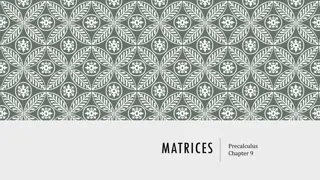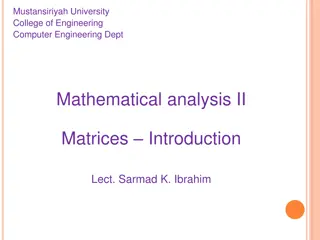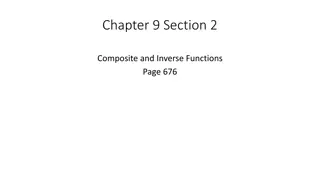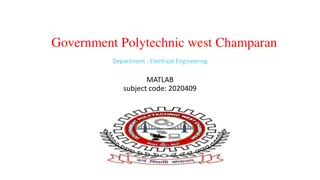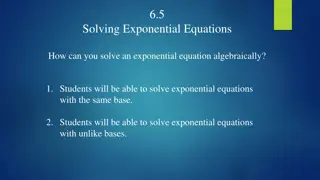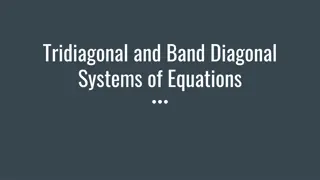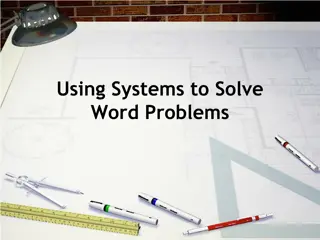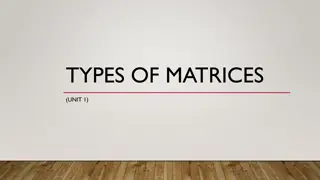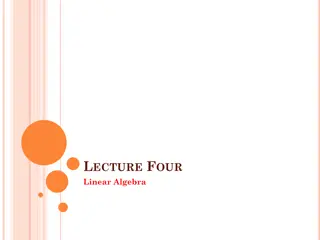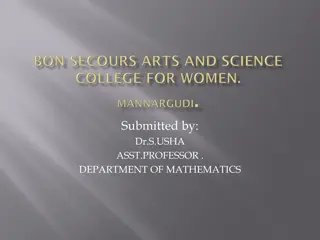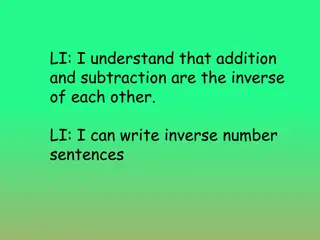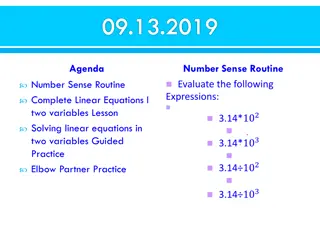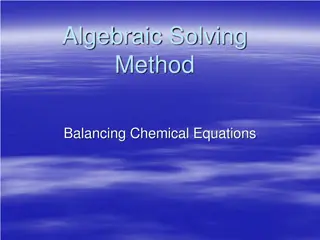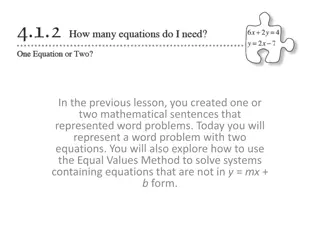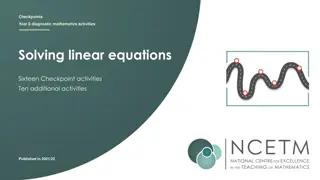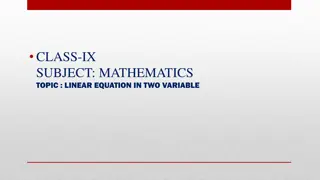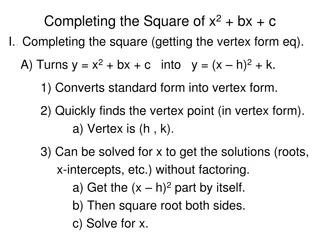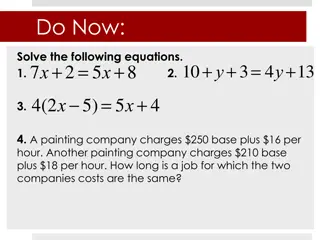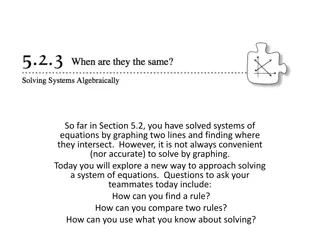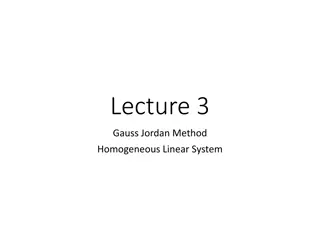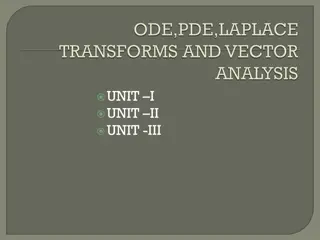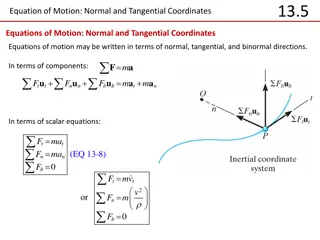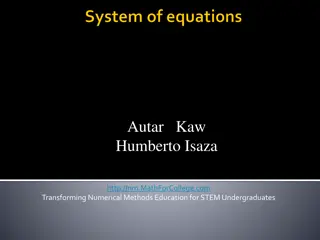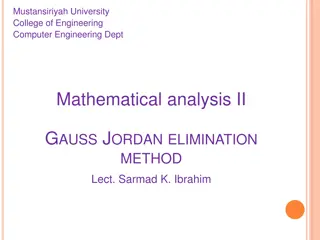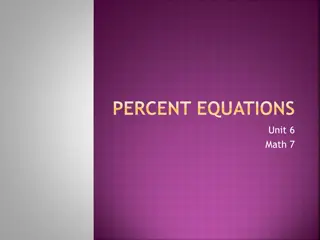Solving Systems of Equations using Inverse Matrices
Learn how to solve systems of equations using inverse matrices, find the determinant of matrices, use matrix multiplication, calculate the inverse matrix, and apply it to solve simultaneous equations. Explore examples and applications in investment scenarios.
Download Presentation

Please find below an Image/Link to download the presentation.
The content on the website is provided AS IS for your information and personal use only. It may not be sold, licensed, or shared on other websites without obtaining consent from the author. Download presentation by click this link. If you encounter any issues during the download, it is possible that the publisher has removed the file from their server.
E N D
Presentation Transcript
Solving systems of equations using inverse matrices
Matrices: Inverses and Systems of equations KUS objectives BAT solve systems of equations using inverse matrices modelling with matrices Starter: find the determinant of each matrix 3 2 3 2 1 2? ? ? + 2 ? + 1 3? 2? 6? 4? 2 5 2
WB11a Use an inverse matrix to solve the simultaneous equations a) ? + 6? 2? = 21 6? 2? ? = 16 2? + 3? + 5? = 24 Write as a matrix multiplication ? ? ? 1 6 2 6 2 1 5 21 16 24 = 2 3 7 28 14 36 9 9 10 13 34 1 Find the inverse matrix (using calc) ??????? ?? 189 Multiply through by the inverse ? ? ? 7 36 9 9 10 13 34 189 756 378 1 4 2 21 16 24 1 1 = = = 28 14 189 189 So the solution is ? = ? ? = ? ? = ?
WB11b Use an inverse matrix to solve the simultaneous equations b) 3? 6? = 0 3? + 3? = 2 3? ? + 3? = 2 Write as a matrix multiplication ? ? ? 3 0 0 3 6 3 3 0 2 = 3 1 2 12 9 9 6 9 3 18 9 9 1 Find the inverse matrix (using calc) ??????? ?? (18) Multiply through by the inverse 43 0 ? ? ? 12 9 9 6 9 3 18 9 9 24 0 12 0 2 1 1 = = = 23 18 (18) 2 So the solution is ? =? ? ? = ? ? =? ?
WB 12 Tyler invested a total of 5000 across three different accounts; a savings account; a property bond and a share dealing account Tyler invested 400 more in the property bond account than in the saving account After one year The savings account increased in value by 1.5% The property bond account had increased in value by 3.5% The share dealing account had decreased in value by 2.5% The total value across Tylers three accounts had increased by 79 ?Saccount ?PB account ?SD account Form and solve a matrix equation to find out how much money was invested by Tyler in each account Total at start is ? + 100 more males at start ? ? ? + ? = ???? = ??? After 1 year 1.015? + 1.035? + 0.975? = ???? ? ? ? 1 1 1 1 0 5000 400 4921 = 1 1.035 1.015 0.975
WB12 (cont) Form and solve a matrix equation to find out how much money was invested by Tyler in each account ? ? ? 1 1 1 1 0 5000 400 4921 = 1 1.035 1.015 0.975 9.75 9.75 20.5 0.6 0.4 0.2 10 10 20 Find the inverse matrix (using calc) ??????? ?? Multiply through by the inverse 220 620 4160 ? ? ? 9.75 9.75 20.5 0.6 0.4 0.2 10 10 20 5000 400 4921 = = ???Saccount ???PB account ????SD account So the solution is Check this works in the original question
WB13 A colony of 1000 mole rats is made up of adult males, adult females and youngsters. Originally there were 100 more adult females than adult males After one year The number of adult males had increased by 2% The number of adult females had increased by 3% The number of youngsters had decreased by 4% The total number mole-rats had decreased by 20 ?adult males ?adult females ?youngsters Form and solve a matrix equation to find out how many of each type of mole- rat were in the original colony Total at start is ? + ? + ? = ???? 100 more males at start ? ? = ??? After 1 year 1.02? + 1.03? + 0.96? = ??? ? ? ? 1 1 1 1 0 1000 100 980 = 1 1.03 1.02 0.96
WB 13 (cont) Form and solve a matrix equation to find out how many of each type of mole-rat were in the original colony ? ? ? 1 1 1 1 0 1000 100 980 = 1 1.03 1.02 0.96 96 96 205 7 100 100 200 1 Find the inverse matrix (using calc) ??????? ?? 6 1 13 Multiply through by the inverse 1300 2600 9100 100 200 700 ? ? ? 96 96 205 7 100 100 200 1000 100 980 1 1 = = = 6 1 13 13 ???adult males ???adult females ???youngsters So the solution is Check this works in the original question
Notes To determine if a system of equations is consistent or inconsistent 1) If the determinant 0 then the system has a unique solution and is consistent Three planes intersect at a single point 2) If the determinant = 0 the matrix is singular then there are two cases i) the matrix is singular and consistent and has infinite solutions Three planes intersect at a line The planes form a SHEAF ii) the matrix is singular and inconsistent and has NO solutions You will meet this more in the chapter on Vectors and planes Three planes do not intersect at the same points anywhere or are parallel
WB 15a For each of the following values of k, determine whether the system of equations below is consistent or inconsistent. If consistent, determine whether there is a unique solution or an infinity of solutions. In each case, identify the geometric configuration of the planes corresponding to each value of k a) k = 0 b) k = 1 c) k = -6 3? ?? 6? = ? ?? + 3? + 3? = 2 3? ? + 3? = 2 ? ? ? 3 ? ? 3 1 6 3 3 ? 2 = 3 2 ? ? ? 3 0 0 3 6 3 3 0 2 a) If k = 0 = 3 1 2 3 0 0 3 6 3 3 3 3 3 0 + 6 0 3 = 3 1= 3 12 6 9 = 18 1 3 3 1 1) If the determinant 0 then the system has a unique solution and is consistent Three planes intersect at a single point
WB 15b For each of the following values of k, determine whether the system of equations below is consistent or inconsistent. If consistent, determine whether there is a unique solution or an infinity of solutions. In each case, identify the geometric configuration of the planes corresponding to each value of k a) k = 0 b) k = 1 c) k = -6 ? ? ? 3 1 1 3 1 6 3 3 1 2 b) If k = 1 = 3 2 3 1 1 3 1 6 3 3 3 3 3 1 1 3 3+ 6 1 3 = 3 1= 3 12 1(12) 6 8 = 0 1 3 3 3 2) If the determinant = 0 the matrix is singular then there are two cases You need to determine if the system is consistent: Eliminate one of the variables from the set of equations. If the resulting two equations are consistent then the system is consistent 3? ? 6? = 1(1) ? + 3? + 3? = 2 3? ? + 3? = 2 (3) 5? + 5? = 5(1)+2x(2) 4? + 4? = 4 (2) (3) (2) the system is consistent: equations (4) and (5) are consistent because one is a linear multiple of the other. Any values of x and y that satisfy (4) also satisfy (5)
WB 15b For each of the following values of k, determine whether the system of equations below is consistent or inconsistent. If consistent, determine whether there is a unique solution or an infinity of solutions. In each case, identify the geometric configuration of the planes corresponding to each value of k a) k = 0 b) k = 1 c) k = -6 ? ? ? 3 6 3 6 3 3 6 2 2 c) If k = -6 = 6 3 1 3 6 3 6 3 3 3 3 3 6 6 3 3+ 6 6 3 3 = 3 1= 3 12 6( 9) 6 15 = 0 6 3 1 3 1 2) If the determinant = 0 the matrix is singular then there are two cases You need to determine if the system is consistent: Eliminate one of the variables from the set of equations. If the resulting two equations are consistent then the system is consistent 3? + 6? 6? = 6(1) 6? + 3? + 3? = 2 3? ? + 3? = 2 (3) 5? 3? = 8(1)+ (3) 15? 9? = 10 2x(1) + (2) (2) the system is Inconsistent and has no solutions: equations (4) and (5) are inconsistent because they are not solvable. No values of y and z satisfy both simultaneously
KUS objectives BAT solve systems of equations using inverse matrices modelling with matrices self-assess One thing learned is One thing to improve is


